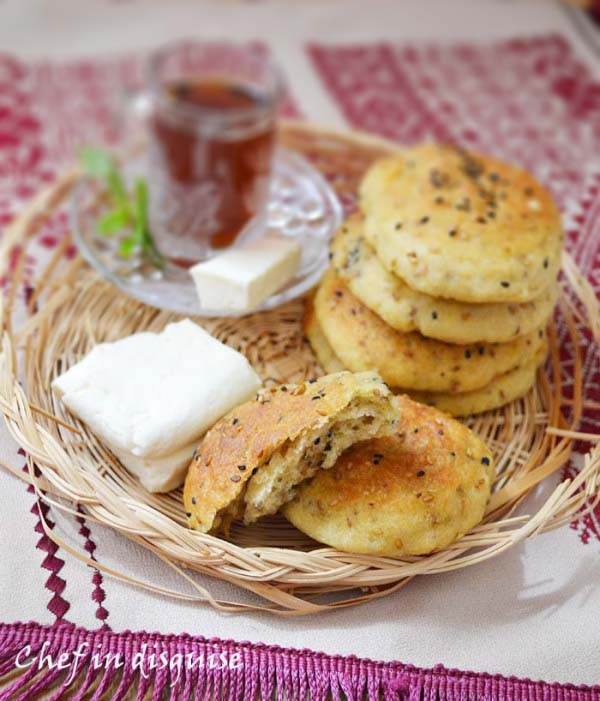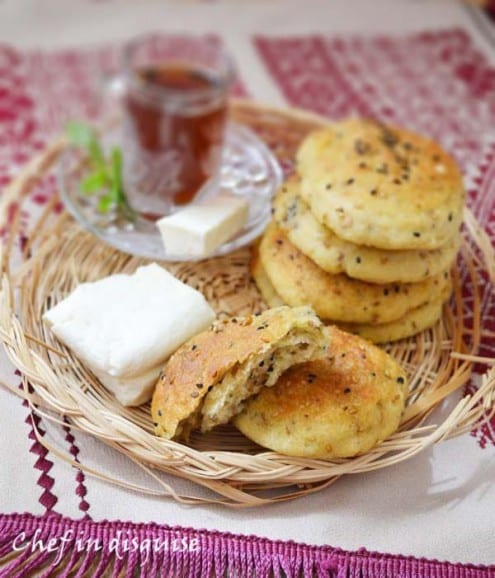Passionate food explorer Sawsan Abu Farha lives in Jordan and…
Olive oil bread, kaaek bel zait or akras el eid is a popular bread in the middle east. It is usually made in the olive pressing season to celebrate the fresh olive oil and a sweetened version of it is made in Eid as a dessert served to friends and family.
By Sawsan Abu Farha
What makes this bread special is the combination of seeds (sesame, Nigella and anise seeds), spices (mahlab, ground anise and ground fennel) and olive oil. The seeds add texture and little bursts of flavor when you bite into them. While the olive oil adds a nutty rich flavor and a beautiful yellowish hue. The characteristic pattern that sets this bread apart comes from the hand carved wooden molds traditionally used in making this bread.
PrintMiddle Eastern Seeds and Olive Oil Bread
5 Stars 4 Stars 3 Stars 2 Stars 1 Star
No reviews
- Author: Sawsan Abu Farha
- Total Time: 2 hours
- Yield: 4 1x
Description
Olive oil bread, kaaek bel zait or akras el eid is a popular bread in the middle east. It is usually made in the olive pressing season to celebrate the fresh olive oil and a sweetened version of it is made in Eid as a dessert served to friends and family.
Ingredients
- 5 cups flour (see notes)
- 2/3 cup olive oil
- 1 cup powdered milk
- 3 teaspoons dry yeast
- 2 teaspoons sugar
- 2 tablespoons anise seeds
- 2 tablespoons sesame seeds
- 1 tablespoon ground anise
- 1/2 teaspoon ground mahlab
- 1/2 teaspoon ground fennel seeds
- 1 tablespoon black sesame seeds (optional)
- 2 cups Water
- Olive oil for brushing the bread
Instructions
- Proof the yeast by mixing the yeast with 1/2 cup of water and the sugar and wait for it to foam and bubble.
- In a bowl, mix the flour, powdered milk, anise seeds, sesame seeds and ground anise, mahlab and fennel.
- Add the olive oil and rub it into the flour mix with your finger tips until the mix resembles wet sand.
- Add the yeast water mix and start kneading the dough.
- Gradually add the water until you get a smooth dough that does not stick to your hands or the bowl.
- Cover the dough and allow it to double in a warm place.
- Preheat your oven to 270 C and position the oven rack in the middle.
- Cut the dough into 20 small balls or 10 big ones depending on the size of the loaves you want.
- Brush your bread mold (if using) with olive oil and roll the dough on top of the bread mold or simply roll the dough into a circle 1 cm in thickness (see notes).
- Arrange the dough circles on a baking sheet that has been brushed with oil or lined with parchement paper, brush with olive oil and sprinkle with sesame seeds.
- Bake in the oven until the bottoms are golden brown.
- Turn on the broiler and allow the top to become golden brown.
- If you like the bread to be richer in flavor, brush the hot bread with some more olive oil. (I usually skip this step).
- Cool the bread on a wire rack and then store in the fridge for 10 days or freeze for up to 3 months.
- Serve with a salty cheese like nabulsi cheese and a cup of tea and enjoy.
Notes
The flour: The outcome of this recipe depends on the type of flour you use. The recipe as listed will give you a soft and chewy bread. I usually use 4 cups white four and one whole wheat flout to get a hint of nutty flavor from the whole wheat flour. If you increase the amount of whole wheat flour to 50% the bread will be crisper, almost cracker like in consistency.The bread in the top picture was made with 4 cups white flour and 1 whole wheat, it comes out soft and chewy. The big ones in the other pictures were made with 50-50 whole wheat and white bread and they were crispier and more cracker like
Thin or thick: Another factor that will greatly affect your finished bread is the thickness you roll the bread into. If you roll the dough thinly (less than 1 cm)the bread will be crisp and almost like crackers. If you roll it thick the bread will be chewy and soft. Do remember that this bread will rise considerably in the oven, it almost doubles in thickness..so keep that in mind when you roll it. The small bread you see in the top picture was rolled to be 1 cm thick , the big loaves in the other pictures were rolled thinner and as a result they were crispier
Wait or bake immediately: Another way to control how soft or crisp your bread will be. If you want the bread to be soft and chewy allow the bread to rest for 15-20 minutes after rolling. If you want it to be crisper, bake it immediately after you roll it.
The olive oil: Some recipes call for kneading the dough with only 1/4 cup of olive oil and brush the rest on top after baking the bread. I personally prefer to add the olive oil to the dough, that results in a richer flavor and softer bread that is more chewy
Don’t have the mold: Don’t worry about it, you can just roll the dough with a rolling pin and decorate it with a fork or the edge of the knife or you can leave it as is. It will still taste amazing
- Prep Time: 1 hour
- Cook Time: 1 hour
Passionate food explorer Sawsan Abu Farha lives in Jordan and enjoys mixing east and west in her kitchen aiming to get the best of both worlds.Juggling work, motherhood, blogging and a passion for food and food photography, she shares her journey in her blog "Chef in disguise".





an old friend from Syria would make a flat bread she caller “Kack”
is this the same bread?
Thank you for sharing this lovely recipe.